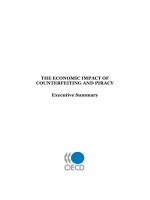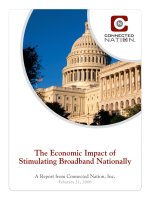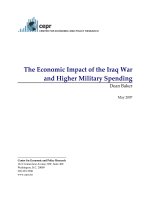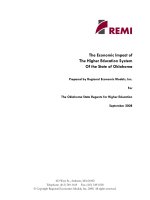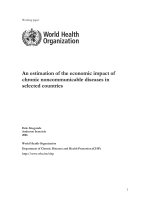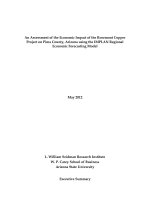Honey Bees: Estimating the Environmental Impact of Chemicals - Chapter 3 pps
Bạn đang xem bản rút gọn của tài liệu. Xem và tải ngay bản đầy đủ của tài liệu tại đây (318.84 KB, 14 trang )
3 Risk assessment of plant
protection products on honey
bees
Regulatory aspects
S. Cluzeau
Summary
Significant changes have occurred over the past few years in European and
French legislation with regard to environmental risk assessment of plant
protection products. Regarding honey bees, the tests requested depend on
the intrinsic characteristics of the product and its method of use. When-
ever the honey bee is likely to be exposed to chemical plant protection
products, during or after treatment, laboratory toxicity tests are requested
leading to the calculation of the hazard quotient. This value determines
the subsequent tests to be carried out: cage tests, tunnel tests, or field tests,
according to the test guidelines harmonized at the European level. In addi-
tion, specific procedures currently available in the United States are pre-
sented.
Introduction
The end of the Second World War was a turning point in the use of plant
protection products in agriculture, with the development of synthetic
chemicals, especially insecticides, organochlorides, and organophosphates.
At this time, the need to produce and therefore to increase yields to
ensure national self-sufficiency was the main priority of a rapidly changing
agriculture. The chemical industry, also expanding rapidly, developed
thousands of new products, providing easy and effective solutions against
various crop enemies [1]. In this context the side-effects of the plant pro-
tection treatments, such as the risk of resistance phenomena or the impact
on beneficial organisms, although inevitable, were not taken into account,
or were ignored [2].
In France, in 1943, a law on the registration of plant protection products
used in agriculture was adopted. The tests required at this time for plant
protection products to become commercialized were limited. They mainly
dealt with the biological efficacy of the product and acute toxicity tests on
rats. No test was requested on the side-effects of the products on nontar-
geted insects, such as pollinator insects. Nevertheless, even at this time,
© 2002 Taylor & Francis
the effects of biocides on man and animals, including game, fish and bees,
were far from negligible [3].
It was not until 1956, following problems of poisoning in bee colonies
observed by beekeepers, mainly on oil seed rape crop, that the public ser-
vices set up specific regulatory provisions on the protection of honey bees
and pollinator insects. The first toxicity tests on honey bees (mainly acute
toxicity) were settled during the 1960s. In the 1970s the development of
synthetic pyrethroids indicated the occurrence of additional side-effects.
Damaging effects on the bees’ behavior were suspected, but were difficult
to characterize, underlining the need for new types of tests.
Since this period and especially over the past 15 years, legislation on the
placing of chemical plant protection products on the market has been con-
tinuously developing to cope with European regulations. Directive No.
91/414/CEE of July 15 1991 [4], later transcribed into French law, defines
the guidelines of the market approval procedure for chemical plant protec-
tion products. The provisions related to the effect on the environment and
on beneficial organisms, in particular bees and other pollinators came to
special importance.
After briefly outlining the different effects that chemical plant protec-
tion products can have on bees, we present the regulatory provisions that
are currently applied in France to limit this impact. We then describe the
European regulation to assess plant protection product risks on bees and
the setting up of new procedures for market approval of chemical prepara-
tions in Europe. Finally, we mention the regulatory provisions applied in
the United States.
Bees and plant protection products: a difficult interaction
The economic value of honey bees relies on the products derived from its
activity (honey, pollen, royal jelly, etc.). Moreover, the honey bee plays a
major role as a pollination agent. Crops of major importance, in fields or
in greenhouses, benefit significantly from the activity of bees: fruit trees,
oil crops (sunflower, oilseed rape), vegetable crops, seed production, etc.
Although the benefits brought through pollination are difficult to put into
figures, in 1982, Borneck and Bricout [5] estimated that entomophilous
crops represented about 27 billion French francs, with 12 percent (i.e. 3
billion French francs) being attributed to pollinator insects. In addition,
the honey bee significantly contributes to the maintenance and develop-
ment of the biodiversity of ecosystems, notably in wild flora.
Bees can be contaminated by chemical plant protection products or
other xenobiotics, either directly or indirectly, immediately or with
delayed effects [6]. They can be poisoned directly during the spraying of
these products in the blooming period through contact with the spray.
They can also encounter product residues when foraging on the plants or
by eating polluted nectar, honeydew, or pollen. In addition, the bee can
Legislation and honey bees 43
© 2002 Taylor & Francis
contaminate the hive by bringing back polluted food, which will be stored
and poison hive bees. In the case of growth regulator insecticides this
effect will be particularly harmful to the larvae. Not only can the domestic
honey bees be affected, but also bumble bees and other insects, such as the
alfalfa leafcutting bee, which is important in the United States.
Over the past 15 years, an increasing number of studies have shown so-
called sublethal effects in the laboratory and under controlled conditions:
delayed mortality, “disappearing disease” [7], decreasing laying rates [8],
effects on the viability of larvae, disturbances of flight, orientation, and
communication [9], and so on. These effects are also strongly suspected by
beekeepers under field conditions, without any formal proof since no
objective means of measurement are yet available.
Although insecticides are the most often involved in damage caused to
the pollinator insects, other plant protection products might also have
negative effects. Thus, fungicides, notably when applied in combination
with insecticides – the most well-known case being the mixture of
deltamethrin and prochloraz, which in the 1980s was responsible for
significant bee mortality [10] – can be responsible for poisoning. With
regard to herbicides, they contribute to a decrease in pollinator insects’
food sources and sometimes can have an insecticide action [6].
Plant protection products and regulatory provisions on
honey bees and pollinator insects in France
As mentioned in the introduction, the first regulatory provisions which
took into account the risk assessment of chemical plant protection pro-
ducts on bees started in 1956. They were progressively modified, leading to
the publication of the July 5 1985 Decree [11], which modified the Febru-
ary 25 1975 Decree [12], and which is still in force.
The July 5 1985 Decree
This text specifies that the use of insecticides and acaricides attacks on all
crops and forestry plantations is forbidden during the flowering period and
the production of honeydew due to aphid attacks. Moreover, products
known to be dangerous to bees should be labelled as being “dangerous to
bees and other pollinator insects” (Table 3.1).
During the flowering period and the production of honeydew, only prod-
ucts with a special exemption can be used. This exemption is granted by the
Ministry of Agriculture on the advice of the Comité d’homologation for a
given utilization and treatment dose level. The Comité d’homologation
bases its opinion on the recommendations of the “bee” section of the Com-
mission d’étude de la toxicité des produits antiparasitaires à usage agricole.
This advice is established after the examination of test results provided by
agrochemical companies (the list of tests is given below). The exemption
44 S. Cluzeau
© 2002 Taylor & Francis
appears on the label as “use authorized during the flowering and honeydew
production periods following aphid attacks.”
Tests required to obtain exemption
Companies requesting authorization to use their product during the flow-
ering period submit to the relevant authorities a toxicological file for each
preparation and for each requested use, allowing the toxicity of the
product for bees to be assessed.
The main tests required are the following:
• Laboratory assessment of LD
50
(at 24 and 48 hours) through contact
or ingestion of the active ingredient and the formulated product; the
official guideline being the CEB test No. 95 method of the Commis-
sion des essais biologiques (CEB) [13].
• Assessment of the effects of application of the product outdoors under
a wire meshed tunnel; the official guideline in France being CEB test
No. 129 [14].
Based on the results of these tests, insecticides and acaricides can be classi-
fied into three groups (Table 3.2). The preparations considered as danger-
ous (Group 1) and as presumed dangerous (Group 2) are forbidden during
flowering and honeydew production periods. The Group 1 preparations
are recognized as toxic and should be labeled “dangerous to bees.” Only
the Group 3 preparations can benefit from exemptions for their use during
Legislation and honey bees 45
Table 3.1 Extract from February 25 1975 Decree relating to the application of
plant protection products for agricultural use [11]
Part II – Provisions relative to the protection of bees and other pollinating insects
(July 5 1985 Decree)
Art. 8 § 1. With a view to protecting bees and other pollinating insects, treatments
involving insecticides and acaricides are forbidden, whatever the product and
application apparatus used, on all crops and forestry plantations visited by these
insects during flowering and during the honeydew production period following
attacks from aphids.
§ 2. As an exemption to this provision, only those insecticides and acaricides with
the following wording: “Use authorized during flowering and honeydew secretion
periods following aphid attacks, provided the doses, means of application and
precautions set out in the sales authorization are respected” may be used during
these periods. These particular wordings must appear on the packaging.
§ 3. Amongst other things, all insecticides and acaricides recognized as being
dangerous to bees and other pollinating insects must carry the wording: “Product
dangerous to bees and other pollinating insects.”
§ 4. When melliferous plants are in flower under trees or in the middle of crops to
be treated, they should be cut or uprooted before treatment.
© 2002 Taylor & Francis
flowering and honeydew production periods. However, Group 2 prepara-
tions, which are presumed dangerous and consequently are forbidden
during flowering, have no indication on their labeling, which leads to a
certain ambiguity.
Limitations in current regulations and problems encountered
Several problems have been encountered which indicate the limitations in
the test methods being used and the difficulty of studying the effects of
plant protection products on bees.
• In the laboratory, the LD
50
of certain plant protection products can
vary by a factor of 10 to 100, and even 1000, depending on the biologi-
cal material used [15].
• Field tests hardly allow the assessment of the effects of certain mol-
ecules, shown to be toxic in the laboratory, in particular the synthetic
pyrethroids. With this kind of product, used at very low doses per
hectare (a few grams), mortality is almost never observed in or near
the hive.
• Tunnel tests allow the estimation of the risk to bees with a product
applied under conditions similar to agricultural practice. However,
these tests are not often repeated because of the complexity of their
set-up and their high cost. Replicates can be conducted over time but
they are subjected to climate variations.
• The problems recently encountered in France with imidacloprid, a sys-
46 S. Cluzeau
Table 3.2 Bee toxicity groups used in France to classify insecticides and
acaricides [27]
Group Hazard group Conditions of use Wording on label
1 Product recognized Not to be used on plants Dangerous to bees
as dangerous to visited by bees or and other pollinators
bees pollinating insects
2 Product presumed Not to be used on plants –
dangerous to bees visited by bees or
pollinating insects
3 Formulations having Authorized for use in Utilization authorized
received at least situations benefiting from during flowering or
an exemption or a the classification honeydew secretion
classification for a periods following
specific use aphid attacks for a
specific use provided
the doses, means of
application and
precautions set out in
the sales authorization
are respected
© 2002 Taylor & Francis
temic insecticide treatment applied on sunflower seeds which is sus-
pected to induce sublethal effects on bees’ behavior, have stressed the
limitations of current test methods.
• The 1985 Decree sets out provisions relating to the use of products
and only concerns insecticides and acaricides. Fungicides and herbi-
cides, which represent a significant part of plant protection product
sales and which may have also adverse effects on bees, are usually not
tested.
European regulation to assess risks of plant protection
products on bees
The European Directive No. 91/414/CEE of July 15 1991 concerning the
registration of plant protection products sets out the conditions which
must be fulfilled to obtain market authorization (Table 3.3). This approval
is carried out in two steps. Approval for the active substance is given at the
level of the European Commission. Authorizations for preparations
remain at the national level. Simplified procedures are planned for the
future to allow authorization to be extended from one country to another.
In France, the European Directive has been transferred into national
law by different decrees and laws. The decree of September 6 1994 [16]
Legislation and honey bees 47
Table 3.3 Main headings of European Directive 91/414/EEC [4]
Annex I Active substances authorized for incorporation in plant
protection products
Annex II Requirements for the file to be submitted by applicants for the
inclusion of an active substance in Annex I
8. Ecotoxicological studies [28]
8.3 Effects on bees
8.3.1 Acute toxicity
8.3.2 Bee brood feeding test
Annex III Requirements for the file to be submitted by applicants for the
authorization of a plant protection product
10. Ecotoxicological studies
10.4 Effects on bees
10.4.1 Acute oral and contact toxicity
10.4.2 Residue test
10.4.3 Cage tests
10.4.4 Field tests
10.4.5 Tunnel tests
Annex IV Risk phrases
Annex V Safety phrases
Annex VI Uniform principles for the evaluation of plant protection
products
© 2002 Taylor & Francis
defines the conditions to be fulfilled in constituting an approval request file
for plant protection preparations. The Decree annexes list the tests
required to register an active substance on a positive list and to ask for
approval for the preparation. The tests required for bees are detailed in
Part 8.3.1 of Annex I for the active substance and in Part 10.4 of Annex II
for the preparation.
Different national and international institutions have established
methods to assess the environmental risk of plant protection products. The
EPPO (European and Mediterranean Plant Protection Organization) and
the Council of Europe have worked to harmonize test methods for the
environmental side-effects evaluation especially on bees. This work has
led to the publication of a decision-making scheme for the environmental
risk assessment of plant protection products [17] (Figure 3.1). This scheme
is common to all the member countries in Europe, but the methods used
are in fact determined by each country.
European regulation is based on the concept of risk which has replaced
that of innocuousness, toxicity being an inherent property of any plant
protection product [18]. Thus, the assessment of the risks involved with a
plant protection product can only be done after laboratory and field tests,
which lead to classifying the product into one of the following categories:
high-, medium-, and low-risk products. Each stage of the procedure leads
to either an assessment of the risk (and therefore classification in one of
the risk categories previously mentioned) or to further tests. This assess-
ment takes into account several factors such as the doses of the product
used, its method of application, and the crop being treated.
Laboratory tests
Acute toxicity of the active substance
The LD
50
values for oral or contact acute toxicity with the active substance
are indicators of the potential impact on bees. Their measurement is com-
pulsory for all plant protection products once bees are susceptible to being
exposed to them. These tests are therefore not requested for products with
particular uses not involving contact with bees (foodstorage in closed
buildings, treatment of seeds or transplanted plants and bulbs, wound
sealing and healing treatment, rodenticidal baits, use in greenhouses with
no pollinating insects).
Acute toxicity of the commercial formulation
Determining LD
50
values (after 48 hours) for a commercial formulation
administered by contact or ingestion routes can be requested when the
formulation contains several active substances or when its toxicity cannot
be predicted from comparisons with those of similar formulations.
48 S. Cluzeau
© 2002 Taylor & Francis
Figure 3.1 Decision-making scheme for the environmental risk assessment of plant
protection products [17].
© 2002 Taylor & Francis
Determining hazard quotients
Establishing LD
50
values allows us to determine the Hazard Quotients
following oral or contact exposure (Q
HO
and Q
HC
) which are calculated
from the LD
50
values and the doses recommended for field treatment.
50 S. Cluzeau
Calculation of the Hazard Quotient
Preparation containing only one active substance (a.s.)
Q
HO
(g a.s./bee)ϭ Dose (g a.s./ha)/oral LD
50
(g a.s./bee)
Q
HC
(g a.s./bee)ϭ Dose (g a.s./ha)/contact LD
50
(g a.s./bee)
Preparation containing several active substances
Q
HO
(g preparation/bee)ϭ Dose (g preparation/ha)/oral LD
50
(g
preparation/bee)
Q
HC
(g preparation/bee)ϭ Dose (g preparation/ha)/contact LD
50
(g preparation/bee)
Dose: maximum application dose for which the authorization is
requested, expressed as grams of active substance per hectare.
The value of the Hazard Quotient is critical for the next step of the assess-
ment procedure. Different types of tests are requested when the value
obtained for the Hazard Quotient is above a threshold value of 50.
The case of insect growth regulators
For these types of substances a test to evaluate the risk for bee brood is
required, unless it has been shown that exposure is highly unlikely (the
official method used is the ICPBR (International Commission for
Plant–Bee Relationships) 1992 method [19]). On the basis of the results
observed, additional cage or tunnel tests may be requested.
Test of residues on foliage
In addition to the other tests, this test can be requested when the risk is
considered as being high (Q
HO
or Q
HC
Ͼ 50). It aims to provide informa-
tion to assess the potential toxicity of product residues on crops for forag-
ing bees. This test should allow us to establish the 50 percent Lethal Time
(LT
50
) expressed in hours. This value gives us an idea of the time period
during which the residues remain toxic to bees.
Tests under controlled conditions and field tests
According to the EPPO, the most reliable risk assessment is based on data
gathered under conditions which are most similar to agricultural practice
© 2002 Taylor & Francis
by setting up field tests. However, owing to the difficulty and cost involved
in setting up such tests, as far as possible they are replaced by laboratory
or cage tests, with the results of the latter taken as being decisive.
Cage tests
These tests are carried out in accordance with the EPPO 170 Directive
[20]. They should allow us to obtain enough information to assess the
potential risks of the plant protection product on the survival and behavior
of bees. They are requested when the risk is considered as high (Q
HO
and
Q
HC
Ͼ 50, or in the case of significant effects on the brood or of suspected
indirect effects: delayed effects, behavior modification, etc.).
Tunnel tests
These tests aim to assess the impact of contaminated flowers or honeydew
on foraging bees. They can be requested when particular effects (toxicity
for larvae, long-term delayed effects, disorientation of bees) have been
observed during field tests. In France, the CEB 129 method is used.
Regulatory situation in the USA
Authorization for plant protection products is governed in general by
the EPA (Environmental Protection Agency) and more precisely by the
OPP (Office of Pesticide Programs). The market approval procedure is
initially at the federal level and then at the level of each state. Thus, the
company requesting approval first submits a request file at the federal
level, and once federal approval has been granted, the company files in
each state in which it intends to commercialize the product. Certain states
may request additional tests, not previously requested by the federal
authority.
The reference text which regulates approval in the United States is the
FIFRA (Federal Insecticide, Fungicide and Rodenticide Act), which is
equivalent to European Directive No. 91/414. This text, which presents the
outlines for the market approval of plant protection products, was consid-
erably amended in 1986 by the Food Quality Protection Act. To compile
their approval registration file, companies must carry out ecotoxicity tests
to assess effects on the environment and in particular on nontargeted
organisms such as bees.
Tests on bees are requested for all products, whether they are insecti-
cides, fungicides, herbicides, rodenticides, or disinfectants, etc., once they
are to be used outdoors and bees may come into contact with them. Three
official test methods, harmonized with those of the OECD [21, 22] and
certified by the OPP, are available (OPPTS Nos 850.3020 [23], 850.3030
[24] and 850.3040 [25]).
Legislation and honey bees 51
© 2002 Taylor & Francis
Acute toxicity tests
If bees can come into contact with the plant protection products, the
contact LD
50
must be measured. Similarly, in the case of possible ingestion
of the product by bees, the oral LD
50
must be established. The method
used is defined by OPPTS Guideline No. 850.3020.
The case of growth regulators
If the product has a growth regulating action, brood food tests are
required.
On the basis of the values obtained for the LD
50
, additional tests may
be requested. Toxicity is measured on the Atkins scale [15] If the LD
50
value is equal to or above 11g/bee, the product is considered as being
almost nontoxic. For LD
50
values between 2 and 11g/bee, the product is
considered as moderately toxic. Below 2g/bee, the product is highly
toxic.
Tests of residues on foliage
When the LD
50
is below 11g/bee, additional tests to assess the toxicity of
residues on foliage may be required. The recommended method is OPPTS
No. 850.3030.
Field tests
It sometimes happens that field tests are requested, especially when the
acute toxicity of the product is high, when the residues are highly toxic or
when the toxicity for other nontargeted species is high or strongly sus-
pected. These tests may be carried out on several economically important
pollinating species: honey bees (Apis mellifera), alfalfa leafcutting bees
(Megachile rotundata), and alkali bees (Nomia melanderi).
Based on the different test results, the EPA decides on the classification
of the product (Table 3.4) and whether the label should carry an indication
that the product must not be used on crops or weed flowers visited or
foraged by bees.
Currently, the EPA is revising the wordings on labels concerning the
protection of bees. According to the proposals under review, the label
should, in addition, mention how long (in days or hours) the product
residues are dangerous for bees.
Conclusion
Apart from the fact that the honey bee is a source of income, it is being
considered increasingly as a bioindicator of the quality of the environment
into which it is introduced [26].
52 S. Cluzeau
© 2002 Taylor & Francis
Over the past few years, regulations concerning the protection of bees
have changed greatly, tending towards a reinforcement in protection. In
Europe, the regulations, based on the fact that the potential toxicity is an
inherent characteristic of the product, have introduced the notions of risk
and nonintentional effects on the environment.
A strict procedure has been put into place. However, questions remain,
particularly in relation to the reliability of the tests requested and their
feasibility. The assessment of the effects of plant protection products is
based on the calculation of the Hazard Quotient, which in turn is based on
the LD
50
. As the latter can vary to a significant degree, the validity of the
Hazard Quotient may be questionable.
Concerning the test methods, some development is required. Questions
encountered recently in France with imidacloprid, a systemic seed treat-
ment applied to sunflowers, have shown the limitations of the existing
methods. In fact, the suspected sublethal effects (changes in bee behavior)
involve extremely low doses and are difficult to demonstrate with cur-
rently available methods.
Similarly, the problem of possible synergic effects, due to product mix-
tures, is not taken into account. Finally, another point which must be
addressed concerns the cumulative effect of successive treatments.
Legislation and honey bees 53
Table 3.4 Honey bee toxicity groups and cautions in the US (EPA)
Toxicity group Precautionary statement if Precautionary statement if
extended residual toxicity is extended residual toxicity
displayed is not displayed
I
Product contains This product is highly toxic This product is highly toxic
any active to bees exposed to direct to bees exposed to direct
ingredient with treatment or residues on treatment on blooming crops
acute LD
50
of less blooming crops or weeds. or weeds. Do not apply this
than 2g/bee. Do not apply this product product or allow it to drift to
or allow it to drift to blooming crops or weeds
blooming crops or weeds if while bees are actively
bees are visiting the visiting the treatment area.
treatment area.
II
Product contains This product is toxic to bees This product is toxic to bees
any active exposed to direct treatment exposed to direct treatment.
ingredient(s) with or residues on blooming Do not apply this product
acute LD
50
of crops or weeds. Do not while bees are actively
2g/bee but less apply this product if bees visiting the treatment area.
than 11g/bee. are visiting the treatment
area.
III
All others No bee caution required. No bee caution required.
© 2002 Taylor & Francis
References
1 Bain, C., Bernard, J.L. and Fougeroux, A. (1995). Protection des Cultures et
Travail des Hommes. Éd. Le Carrousel, p. 264.
2 Leufeuvre, J.C. (1985). Intensification de l’agriculture et usage des produits
insecticides: évaluation des risques pour les équilibres biologiques, la faune et
la santé humaine. In: Coll. Mode d’Action et Utilisation des Insecticides, Angers.
Éd. ACTA, 19–22 nov. 1985, pp. 9–70.
3 Borneck, R. (1987). Rôle et protection des abeilles – Organisation de la profes-
sion apicole – Efforts internationaux. La Défense des Végétaux, 243–244, 3–7.
4 EEC (1991). Council directive 91/414/EEC of 15 July 1991 concerning the
placing of plant protection products on the market. Off. J. Eur. Comm. 230,
1–32.
5 Borneck, R. and Bricout, J.P. (1984). Évaluation de l’incidence économique de
l’entomofaune pollinisatrice. Bull. Tech. Apic. 47, 117–124.
6 Taséi, J.N. (1996). Impact des pesticides sur les abeilles et les autres insectes
pollinisateurs. Courrier de l’environnement de l’INRA 29, 9–18.
7 Bendahou, N., Fléché, C. and Bounias, M. (1999). Biological and biochemical
effects of chronic exposure to very low levels of dietary cypermethrin
(Cymbush) on honeybee colonies (Hymenoptera: Apidae). Ecotoxicol. Environ.
Saf. 44, 147–153.
8 Lensing, W. (1986). Veränderungen bei den Arbeiterinnen der Honigbiene
nach Fütterung von Dimethoat in subletalen Dosen. Apidology 17, 339–342.
9 Vandame, R., Meled, M., Colin, M.E. and Belzunces, L.P. (1995). Alteration of
the homing-flight in the bee Apis mellifera L. exposed to sublethal dose of
deltamethrin. Environ. Toxicol. Chem. 14, 855–860.
10 Colin, M.E. and Belzunces, L.P. (1992). Evidence of synergy between prochlo-
raz and deltamethrin: A convenient biological approach. Pestic. Sci. 36, 115–116.
11 Journal officiel de la République Française (1985). Arrêté du 5 juillet 1985
relatif à la délivrance d’autorisation d’emploi de produits antiparasitaires à
usage agricole. JO du 12 juil. 1985, p. 7867.
12 Journal officiel de la République Française (1975). Arrêté du 25 février 1975
fixant les dispositions relatives à l’application des produits antiparasitaires à
usage agricole. JO du 7 mar. 1975, p. 2563.
13 ANPP (1982). Méthode CEB no. 95 – Méthode de laboratoire d’évaluation de
la toxicité aiguë orale et de contact des produits phytopharmaceutiques chez
l’abeille domestique Apis mellifera L. Première édition, avril 1982, révision
nov. 1996, p. 7.
14 ANPP (1989). Méthode CEB no. 129 – Méthode d’évaluation, sous tunnel en
plein air, des effets à court terme des produits phytopharmaceutiques sur
l’abeille domestique Apis mellifera L. Première édition, janvier 1989, révision
nov. 1996, p. 12.
15 Atkins, E.L., Kellum, D. and Atkins, K.W. (1981). Reducing pesticide hazards
to honey bees: mortality prediction techniques and integrated management
strategies. University of California, Division of Agricultural Sciences. Leaflet,
883, p. 22.
16 Journal officiel de la République Française (1994). Arrêté du 6 septembre 1994
portant application du décret no. 94–359 du 5 mai 1994 relatif au contrôle des
produits phytopharmaceutiques, JO du 23 déc. 1994.
54 S. Cluzeau
© 2002 Taylor & Francis
17 EPPO (1999). Decision-making scheme for the environmental risk assessment
of plant protection products. Bull. OEPP/EPPO 23, 59–65.
18 Sauphanor, B., Belzunces, L. Brun, J., Chabert, A. and Colin, M.E. (1992). Pro-
duits phytosanitaires et organismes utiles, une approche européenne. Phytoma-
la Défense des Végétaux, 445, 13–22.
19 Oomen, P.A., De Ruijter, A. and Van Der Steen, J. (1992). Method for honey-
bee brood feeding tests with insect growth-regulating insecticides. Bull.
OEPP/EPPO 22, 613–616.
20 OEPP (1992). Guideline for the efficacy evaluation of plant protection prod-
ucts – Side-effects on honeybees – directive PP 1/170 (2). Bull. OEPP/EPPO
22, 203–216.
21 OECD (1998). 213 Guidelines for the testing of chemicals – Honeybees, acute
oral toxicity test. Adopted 21 September 1998, p. 8.
22 OECD (1998). 214 Guidelines for the testing of chemicals – Honeybees, acute
contact toxicity test. Adopted 21 September 1998, p. 8.
23 US EPA (1996). Honey bee acute contact toxicity test (OPPTS 850.3020).
Ecological effects test guidelines. EPA 712-C-96-147. Washington DC, USA.
24 US EPA (1996). Honey bee toxicity of residues on foliage test (OPPTS
850.3030). Ecological effects test guidelines. EPA 712-C-96-148. Washington
DC, USA.
25 US EPA (1996). Field testing for pollinators (OPPTS 850.3040) Ecological
effects test guidelines. EPA 712-C-96-150. Washington DC, USA.
26 Rivière, J.L. (1993). Les animaux sentinelles. Courrier de l’environnement de
l’INRA 20, 59–67.
27 ACTA (1990). Réglementation française des produits phytosanitaires, 4
e
édition, p. 448.
28 EEC (1996). Commission directive 96/12/EC of 8 March 1996 amending
Council directive 91/414/EEC of 15 July 1991 concerning the placing of plant
protection products on the market. Off. J. Eur. Comm. 65, 20–37.
Legislation and honey bees 55
© 2002 Taylor & Francis



